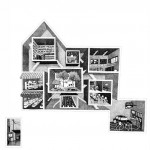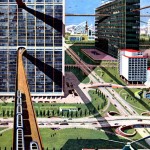At 10-12 Travessa do Cabo, in the Lisbon district of Estrela, you will find an old repair garage, or so you will think if you simply walk past. Behind the rusty metallic gate hides, in fact, the location of one of the most significant Portuguese architectural firms in recent years. A duo, Patrícia Barbas and Diogo Seixas Lopes, has recovered this space and transformed the interiors just enough to accommodate tables, computers and a rich library without bothering to put on display their name on the facade. Such an understated and sensitive attitude also characterizes the work of the young office that last week lost one of his two associates, Diogo Seixas Lopes, untimely passed away at the age of 43 years.

Diogo Seixas Lopes during the works at the Thalia Theatre in Lisbon – photo © Lígia Matos Ribeiro
A complex and passionate intellectual, architect, writer and curator, Diogo was appointed, with André Tavares, as director of the upcoming Lisbon Architecture Triennial Exhibition of 2016, just as the publication of his book “Melancholy and architecture. On Aldo Rossi“, an original reading of the figure of Aldo Rossi and his plan for the cemetery of San Cataldo under the lens of the architect’s confrontation with death, was being widely acclaimed by critics and audiences.

Diogo Seixas Lopes – Melancholy and architecture. On Aldo Rossi. Park Books
Diogo was carrying on a work in which theory and practice of architecture are essentially tied together, believing that the very sense of the profession lies in the formulation of a theory that will translate into matter and form through the project.
A Lisbonense, lover of his city yet internationally trained, visiting scholar at the CCA in Montreal and recent PhD in Zurich, Diogo was helping to open up the landscape of contemporary Portugal to international culture by working in collaboration with the Swiss Peter Märkli and imagining the new edition of the Triennale as a dialogue between authors from different countries on the universal theme of form, its origin and its multiple meanings. Diogo believed in architecture as a common ground for dialogue and collaboration between individuals of different cultures, origins and generations, both in his architectural manifestations and in editorial ventures like that of Prototypo magazine.
In 2012, in association with Gonçalo Byrne, Barbas Lopes office has completed the reconstruction and integration of the Thalia Theater in Lisbon transforming a ruin dating back to a century into a vital civic centre. The “fossil” of the existing theatre is enclosed within new walls of stained exposed reinforced concrete forming a monolithic assembly, divided into juxtaposed volumes characterized by pure form and monumental scale. A glazed one-story porch sits along the main body denying its strength and making the whole an urban piece. The building, enveloped in a timeless aura, escapes both fashionable accents and a trivial contextualism, and is destined to become an essential piece of a city in renaissance.
The work of Barbas-Lopes marry intellectual rigour with the economy of means in a Portugal in times of crisis to let every project be an opportunity for rethinking the architectural practice. Diogo Seixas Lopes, with his ability in combining constructive realism and conceptual refinement was an original voice in Europe, a figure committed to bind different eras and contexts, and, as his colleague and friend André Tavares wrote in his touching memory: an architect able to express a political ethos through a poetic pathos.
Mariabruna Fabrizi and Fosco Lucarelli
(This post originally appeared in Italian in the online magazine Artribune on February 26th, 2016 as “Diogo Seixas Lopes, un ricordo per immagini e parole“)

Barbas Lopes Office, Travessa do Cabo, Lisbona – Interior Design by Barbas Lopes – photo © Sérgio Catumba

Barbas Lopes Office, Travessa do Cabo, Lisbona – Interior Design by Barbas Lopes – photo © Sérgio Catumba

Barbas Lopes Office, Travessa do Cabo, Lisbona – Interior Design by Barbas Lopes – photo © Sérgio Catumba
All images © the respective authors.





A huge lost in the (portuguese) architectural scene.
Diogo Seixas Lopes was definitly one of the most important architects of his generation living today.
He embbraced theory and practice in one unique force, producing very interesting work to reach essential achievements.
Thanks for this tribute